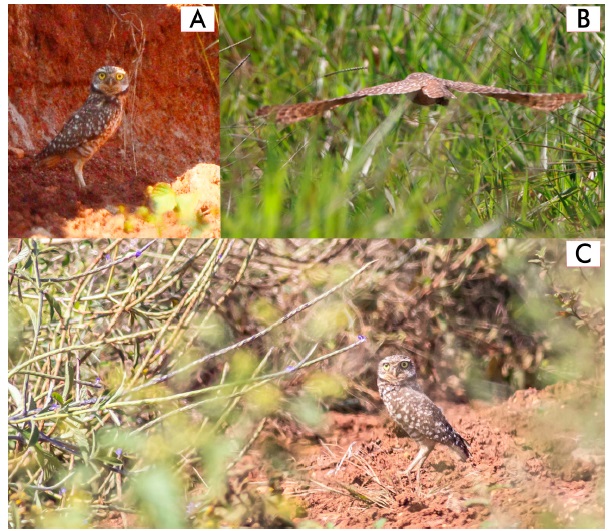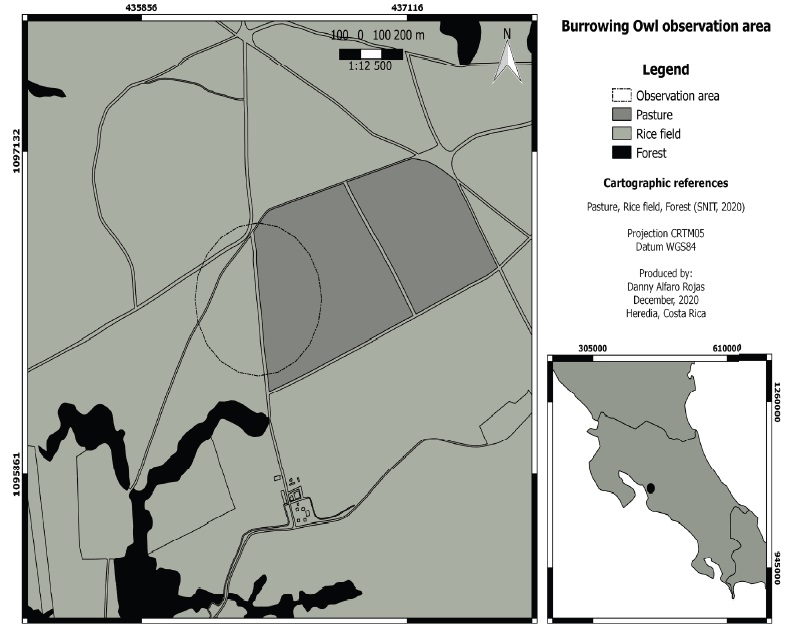Introduction
The Burrowing Owl (Athene cunicularia) is a ground-dwelling small owl (19-25 cm total length), with long legs, inconspicuous brown plumage, and bright yellow iris. It has rounded head, a facial disc with white stripes and edges and white eye brows; this, along with the species’ diurnal habits and ground-dwelling behavior make it unmistak able (Stiles and Skutch 2007, Poulin et al. 2020). According to Poulin et al. (2020) the subspecies Athene cunicularia hypugaea is distributed from east Oregon to west Kansas, south to Baja Califor nia Sur, and through Mexico to Honduras, with va grant individuals occurring south to Costa Rica and Panama.
This owl is widely distributed in prairie and agricultural areas, deserts, steppes, and grasslands along the American continent (Poulin et al. 2020). It should be noted that there are two main areas of distribution: one from North America to Hondu ras, and another in South America, with a gap in the southern part of Central America (Poulin et al. 2020). For Central America, the Burrowing Owl is considered a vagrant and/or migratory species, with few reports in Honduras, El Salvador, Guatemala, Panama, Nicaragua, and Costa Rica (Dickey and van Rossem 1938, Komar 1998, Jones and Meer man 2017, Thorstrom and Gallardo 2017, Chavar ría-Duriaux et al. 2018). In Costa Rica, the last con firmed record is represented by a male Burrowing Owl, collected in Los Cuadros on the Southwestern slope of the Irazú volcano in December 1900, and is kept in the American Museum of Natural History (AMNH - 485,400). There were two anecdotal re ports of the species in Guanacaste, Costa Rica, one in 1980 for the northern area of Guanacaste, and an other near the Rincón de la Vieja National Park in 2005. However, neither of these reports were con firmed as no evidence of the sightings were provid ed, nor were they properly documented (Slud 1964, Stiles and Skutch 2007, Garrigues and Dean 2014, Camacho-Varela and Arguedas-Porras 2017).
Observation Description
On 28 November 2020 at 13:30 h whilst bird watching, we observed a small owl on the ground at the side of a dirt road between a rice field and grassland area at Finca La Ceiba (9.916376º N, 84.579974º O), Orotina, Alajuela province, Costa Rica (Figure 1). We distinguished the individual as a Burrowing Owl by the yellow eyes, plumage markings, and typical posture of this species on the ground (Figure 2a). The bird flew low to the ground (Figure 2b) for 30 m, and on being attacked by a Tropical Kingbird (Tyrannus melancholicus), the Burrowing Owl sought refuge among grass and Stachytarpheta sp. vegetation at the side of the road.

Figura 2 Observation of Burrowing owl on 28 November 2020 in La Ceiba, Orotina, Costa Rica. First ob servation by a dirt road between a rice field and grassland area (A), flight movement between grassland area (B) and second observation (C). Photographs by Beto Guido (A), Danny Alfaro-Rojas (B) and Roberto Var gas-Masís (C).
The individual adopted a “ground chest” posi tion with legs prepared to push into flight when we approached to within 10-20 m. This elusive behav ior was repeated twice during 20 mins of observa tion. The owl again flew 50 m from the site of initial observations, and we continued to observe the indi vidual for 10 mins until lost from sight in adjacent vegetation (Figure 2c).
Discussion
Our sighting represents the first confirmed re cord of the Burrowing Owl in Costa Rica after 120 years since its last official record. Multiple condi tions could favor new sightings of the species at this site. In the last five years there has been a high number of tropical storms and hurricanes that could have influenced migratory movement of this Bur rowing Owl individual. The effects of storms on the migratory movement of birds have been well docu mented in areas of high hurricane impact such as the Island of Cozumel (Perdomo-Velázquez et al. 2017) and in Puerto Rico (Lloyd et al. 2019). Climatic phenomena alter the distribution of birds, and hur ricanes are very strong temporary events that affect the distribution of populations and their migratory routes suffer short-term changes (Wiley and Wun derle 1993).
The individual was observed in an agricul tural field where rice and grass are harvested. The field has many areas devoid of vegetation, resem bling the grasslands that the Burrowing Owl usual ly inhabits. The site is similar to habitats where the Burrowing Owl is resident at similar latitudes and altitudes, and meets the environmental conditions required by the species (Poulin et al. 2020). The Burrowing Owl is considered a generalist predator, it feeds on mammals, birds, amphibians, reptiles and bases its diet on invertebrates such as beetles, termites, grasshoppers, caterpillars, dragonflies, scorpions, and some crustaceans (Andrade et al. 2020). However, despite the large number of inver tebrates consumed, vertebrates such as mice, birds, bats, squirrels, shrews, snakes, amphibians, turtles, among others, represent the greatest contribution of biomass in the diet of the Burrowing Owl (Cavalli et al. 2013, Orihuela-Torres et al. 2018, Poulin et al. 2020). Therefore, it is useful to do a study on the abundance of these prey to determine if the site has the conditions to maintain the species, and if this is one of the factors that made the species arrive at the place
During our observation the owl maintained a distance of 10-20 m from the observers. The indi vidual showed elusive behavior typical of the Bur rowing Owl, taking refuge between mounds of soil and vegetation in a crouched chest-down position. Butts (1973) mentions that the species prefers to es cape from danger, either by retreating to a burrow or by flying short distances or taking refuge in the vegetation if there is a potential danger. It is worth mentioning that this individual was not observed entering a tunnel, this could perhaps indicate that it is an individual in migration.
The ecological characteristics of the area make this site an ideal habitat for multiple bird species with specific ecological requirements, including rare and accidental species recently reported at the site (eBird 2022). The area had been destined for construction of a new airport in Costa Rica, as stud ies considered this area to have the best orographic, meteorological, and environmental conditions, as well as accessibility to public transport networks (Segnini-Villalobos 2020). These flight conditions also create an easily accessible route with a suitable environment that migratory birds can use to stop-over, rest and forage. However, the airport project was halted due to multiple social and administrative reasons, which is why this observation and that of other rare species are considered records of great importance for the conservation of species and their habitats in the area.
Our observation is also important for ornitho logical study in Costa Rica and the Central Amer ican region, as well as throughout the species’ dis tribution. In North America and South America, conservation efforts are carried out for Burrowing Owl (Burrowing Owl Conservation Network), and records of migratory movements represent valuable data for conservation. Furthermore, we emphasize the value of the site as habitat for migratory and resident species, highlighting the importance of its conservation to preserve the high biodiversity of the region.











 nueva página del texto (beta)
nueva página del texto (beta)



